Configure the top link bar for site navigation
The top link bar helps users of your site navigate to other sites in the site collection by displaying a row of tabs at the top of pages in the site. The top link bar is also referred to as global navigation, because it can be the same across all of the sites in a site collection. However, subsites can be configured to not display in the top link bar of the parent site. The options available to you for configuring your top link bar will vary depending on whether the publishing features are enabled for your site collection.
Following is an example of a top link bar from the fictitious Contoso site. Marketing, Sales, and Finance are subsites of the Contoso parent site.
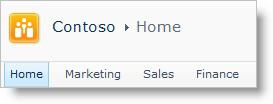
You can also set up the Quick Launch for navigation. To learn how, see Configure the Quick Launch for site navigation.
In this article
Before you begin
Do you have the necessary permissions to configure navigation?
To manage navigation for a site you must have at least the permissions obtained by being added to the default Designers SharePoint group for the site. You have the necessary permission to configure navigation for your site if Site Settings is an option on the Site actions menu  and on the Sites Settings page you see the Navigation command under Look and Feel (on non-publishing sites, you will see the Quick Launch and Top link bar commands under Look and Feel instead of Navigation.
and on the Sites Settings page you see the Navigation command under Look and Feel (on non-publishing sites, you will see the Quick Launch and Top link bar commands under Look and Feel instead of Navigation.
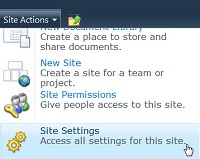
Is publishing enabled for your site?
Before you start to configure the navigation for your site, you need to determine whether or not the publishing features are enabled for the sites in your site collection. It is important to know whether or not your site is a publishing site because the navigation configuration options for a publishing site are more extensive than those available for a non-publishing site.
Depending on which type of site you have, you will see different navigation options on the Site Settings page. Here's how you can quickly determine which type of site you are working with:
-
On the Site Actions menu
 , click Site Settings.
, click Site Settings. -
Look at the list of links on the Site Settings page under Look and Feel.
-
If you see a link titled Navigation, then you are working with a publishing site and you can configure your site using the Navigation Settings page.

-
If you see links titled Top link bar and Quick Launch, then you are working with a non-publishing site and you have a more limited set of navigation configuration options available to you.
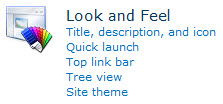
-
Breadcrumb navigation
You cannot configure the breadcrumb navigation. Following is an example of breadcrumb navigation.

Configure inheritance for the top link bar
You can configure the top link bar for a site to use the same top link bar as the parent site. In other words, the subsite inherits the top link bar from the parent site. Alternatively, you can configure the top link bar for a site to be unique to that site
The options and procedures for configuring inheritance for the top link bar differ between publishing sites and non-publishing sites. For information about how to determine whether or not the publishing features are enabled for the sites in your site collection, see Is publishing enabled for your site in this article.
Configure inheritance for the top link bar on a non-publishing site
When you create a new site in a site collection for which the publishing features are not enabled, you can choose whether to include the site on the top link bar of the parent site and whether to use the top link bar from the parent site. This provides you with three different configuration options for your site:
-
Inherited and included in parent The site is included as a tab on the top link bar of the parent site and uses the same top link bar as the parent site. The top link bar cannot be configured at this level without first breaking the inheritance from the parent site.
-
Inherited not included in parent The site uses the same top link bar as the parent site but is not included as a tab on the top link bar of the parent site. The top link bar cannot be configured at this level without first breaking the inheritance from the parent site.
-
Unique The site is not included as a tab on the top link bar of the parent site and does not use the same top link bar as the parent site. The top link bar is configurable at this level and is completely separate from the parent site.
If a site is renamed from the Title, Description, and Icon page, the site name is not updated on the top link bar. To change the name that appears on the top link bar, you must edit the top link bar.
When you create a subsite, it appears by default on the top link bar of the parent site and has a unique top link bar. You can change these setting at any time. To configure the top link bar settings for a subsite:
-
On the Site actions menu
 , click Site settings.
, click Site settings. -
In the Look and Feel column, click Top link bar.

-
Do one of the following:
-
To create custom links for the subsite, click Stop Inheriting Links. The links from the top link bar of the parent site are not retained when you configure the subsite to stop inheriting links.
-
To use the same links as the parent site, click Use Links from Parent. The links on the top link bar of the subsite be deleted when you configure the subsite to use the same top link bar as the parent site.
-
Configure inheritance for the top link bar on a publishing site
When you create a publishing site, you can choose whether or not to use the top link bar from the parent site. You can change these setting at any time use the Navigation Settings page. To configure the top link bar settings for a subsite:
-
On the Site Actions menu
 , click Site Settings.
, click Site Settings. -
In the Look and Feel column, click Navigation.

Notes The Navigation command appears under Look and Feel only if the publishing features are enabled for your site and you have at least the permissions obtained by being added to the default Designers SharePoint group for the site. -
In the Global Navigation section, do one of the following:
-
To display the same top link bar as the parent site, select Display the same navigation items as the parent site.
-
To display a top link bar that is unique to the current site, select Display the navigation items below the current site.

Note: These options will not be available if you are at the top level site in your site collection, because a top level site does not have a parent site.
-
-
In the Global Navigation section,
-
To display the subsites of the current site on the top link bar, select Show subsites.
-
To display the pages of the current site on the top link bar, select Show pages.
-
To limit the number of links to sites and pages that are automatically displayed on the top link bar, type the number for Maximum number of dynamic items to show within this level of navigation.
-
-
Click OK.
Add, edit, or remove a link from the top link bar
The steps you take to add, edit, or remove links from the top link bar differ depending on whether the publishing features are enabled for your site collection. For information about how to determine whether or not the publishing features are enabled for the sites in your site collection, see Is publishing enabled for your site in this article.
Add, edit, or remove links from the top link bar of a non-publishing site
If your site is using a unique top link bar (that is, it is a top-level site or it does not inherit its top link bar from a parent site), you can configure the links that appear on the top link bar for the site. You can also include links to other sites outside of your site collection.
-
On the Site actions menu
 , click Site settings.
, click Site settings. -
In the Look and Feel column, click Top link bar.
-
Do one of the following:
-
To add a new link, click New Navigation Link. Type the URL and a description for the link. The URL can link to any valid path, such as a folder within this site, a share within your organization's intranet, or a link to a location on the internet.
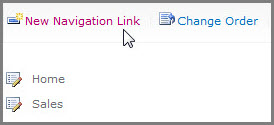
-
To edit a link, click the Edit button beside the link that you want to edit
 and make any necessary changes. You can only edit the description for the default links, such as Home.
and make any necessary changes. You can only edit the description for the default links, such as Home. -
To remove a link, click the Edit button beside the link
 , click Delete, and then click OK.
, click Delete, and then click OK.Important: When you delete a heading from the top link bar on a non-publishing site, any links contained under that heading are also deleted.
-
-
Click OK.
Add, edit, or remove links from the top link bar of a publishing site
You can use the Navigating Editing and Sorting section of the Navigation Settings page to add a new heading or link or to edit an existing heading or link in the top link bar.
-
On the Site actions menu
 , click Site settings.
, click Site settings. -
Under Look and Feel, click Navigation.
Note: The Navigation command appears under Look and Feel only if the publishing features are enabled for your site and you have the at lease the permissions obtained by being added to the default Designers SharePoint group for the site.
-
In the Navigation Editing and Sorting section, click Global Navigation to select the top link bar.
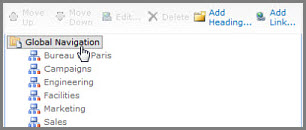
Note: If you do not see lists of links organized under the headings Global Navigation or Current Navigation, your site might inherit its Global Navigation from its parent site. In this case, you will be limited to adding or editing links in the Quick Launch unless you want to stop inheriting Global Navigation from the parent site.
-
Do one of the following:
-
If you want to edit a heading or link, select a heading or link, and then click Edit.
-
If you want to add a new heading, click Add Heading.
-
If you want to add a new link, click Add Link.
Note: If you select a heading, the link will be added under that heading. If you select a link, the link you create will be added to the same level as the link you selected.
-
If you want to remove a heading or a link, in the Navigation Editing and Sorting section, select the heading or link to remove, and then click Delete.
Note: When you delete a heading from the top link bar on a publishing site, the links contained under that heading are not deleted and they will display as headings once their original heading is deleted.
-
-
In the Web dialog box that appears when you add or edit an item, configure the following:
-
Title Type the title of the heading or link as you want it to appear. Title is required.
-
URL Type the URL for the heading or link. A URL is required for links but is optional for headings.
If you want the URL to open in a Web browser window different than that used by the site, select the Open link in new window.
-
Description Type a description for the heading or link. Description is an optional setting.
-
Audience If you want to restrict visibility, enter or browse to an audience for the heading or link. Only the audiences you enter can see the link or heading (and everything under the heading). If you do not enter any audiences, all audiences can see the link. Audience is an optional setting.
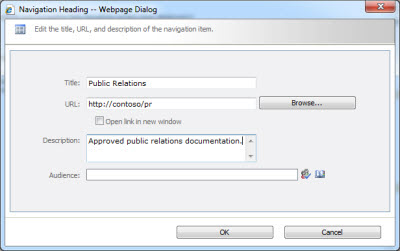
-
-
Click OK.
Change the order of links on the top link bar
The steps you take to reorder links on the top link bar differ depending on whether the publishing features are enabled for your site collection. For information about how to determine whether or not the publishing features are enabled for the sites in your site collection, see Is publishing enabled for your site in this article.
Change the order of links on the top link bar of a non-publishing site
You can change the order in which the tabs are displayed on the top link bar. Any changes that you make to the order of items on the top link bar are reflected in any sites that inherit top link bar navigation from your site.
-
On the Site actions menu
 , click Site settings.
, click Site settings. -
In the Look and Feel section, click Top link Bar.
-
Click Change Order.
-
In the Link Order column, click options in the lists to change the order in which the links appear on the top link bar.
-
Click OK.
Manually change the order of links on the top link bar of a publishing site
-
On the Site actions menu
 , click Site settings.
, click Site settings. -
In the Look and Feel section, click Navigation.
Note: The Navigation command appears under Look and Feel only if the publishing features are enabled for your site and you have the at lease the permissions obtained by being added to the default Designers SharePoint group for the site.
-
In the Navigation Editing and Sorting section, under Global Navigation, select the item you want to move, and then do one of the following:
-
To move an item to the left on the top link bar, click Move Up
-
To move an item to the right on the top link bar, click Move Down.
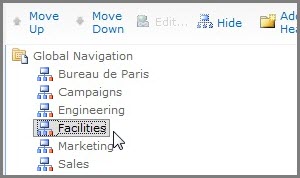
-
-
Repeat step 3 to change the order of any additional items.
-
When you are finished reordering items, click OK.
Automatically sort items on the top link bar on a publishing site
If you are working on a site for which the publishing features are enabled, you can configure navigation items to sort automatically, such as by title.
Important: The Sorting settings apply to both the top link bar and the Quick Launch. Any changes you make are applied to both of these navigation elements.
-
On the Site actions menu
 , click Site settings.
, click Site settings. -
In the Look and Feel section, click Navigation.
Note: The Navigation command appears under Look and Feel only if the publishing features are enabled for your site and you have the at lease the permissions obtained by being added to the default Designers SharePoint group for the site.
-
In the Sorting section, select Sort automatically to sort subsites, navigation links, lists, libraries, and pages automatically in ascending or descending alphabetical or numerical order based on items Titles, Created Dates, or Last Modified Dates.
If you want to sort all navigation items manually except for pages, click Sort manually, and then select the Sort pages automatically check box. Only pages will be sorted according to the settings configured in the Automatic Sorting section.
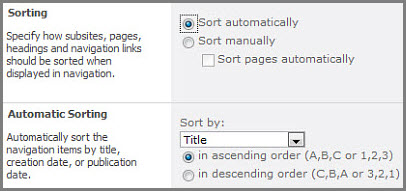
-
In the Automatic Sorting section, in the Sort by list, do one of the following:
-
To sort items by title, select Title.
-
To sort items by the date they were created, select Created Date.
-
To sort items by the date on which they were last modified, select Last Modified Date.
-
-
Specify the sort order by selecting either in ascending order (A,B,C or 1,2,3) or in descending order (C,B,A or 3,2,1).
-
Click OK.
-
Show or hide subsites and pages on the top link bar
If you are working on a site for which the publishing features are enabled, you have the option of showing or hiding pages and subsites on the top link bar.
-
On the Site actions menu
 , click Site settings.
, click Site settings. -
In the Look and Feel section, click Navigation.
Note: The Navigation command appears under Look and Feel only if the publishing features are enabled for your site and you have the at lease the permissions obtained by being added to the default Designers SharePoint group for the site.
-
In the Navigation Editing and Sorting section, do one of the following:
-
If you want to show a subsite or page that is hidden, select the item, and then click Show.
-
If you want to hide a subsite or page that is currently visible on the top link bar, select the item, and then click Hide.

Notes:
-
The Hide and Show commands are available only for navigation items that are subsites or pages. You cannot hide headings or links.
-
When you select an item that is currently visible in the Quick Launch, only the Hide option is available. When you select an item that is currently hidden in the Quick Launch, only the Show option is displayed.
-
-
Display subsites on drop-down menus in the top link bar
If you are working on a publishing site, you can specify whether you want subsites and pages of your site to be displayed automatically in the top link bar. In the top link bar, subsites and pages of the current site display as new tabs (this assumes the site is not inheriting its navigation from a parent site). If you choose to show subsites and/or pages for all of the sites in your site collection, subsites and pages underneath subsites of the top-level site display as links in drop-down menus from the relevant tabs in the top link bar.
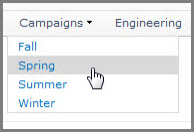
Note: If you decide to display navigation items for subsites or pages, your site may appear cluttered if your site has many subsites or pages. If the structure of your overall site collection is not going to be centrally planned or managed, you might want to configure your site so that subsites and pages do not automatically display.
-
On the Site actions menu
 , click Site settings.
, click Site settings. -
In the Look and Feel section, click Navigation.
Note: The Navigation command appears under Look and Feel only if the publishing features are enabled for your site and you have at least the permissions obtained by being added to the default Designers SharePoint group for the site.
-
In the Global Navigation section, do one of the following:
-
To show links to subsites in the top link bar, select the Show subsites check box.
-
To show links to pages in the top link bar, select the Show pages check box.
-
To hide links to subsites in the top link bar, clear the Show subsites check box.
-
To hide links to pages in the top link bar, clear the Show pages check box.
-
If you configure your site to show subsites and pages, but your site is set up to display the global navigation (top link bar) for its parent site, you will not see links to these subsites and pages in the navigation for your current site unless the navigation for the parent site is also configured to display subsites and pages.
-
If you are configuring navigation for a top-level site, and you want pages or subsites underneath the subsites of the top-level site to appear on drop-down menus from the top link bar, you need to configure the top level site to show subsites and pages, and you also need to configure the individual subsites to show their subsites and pages.
-
If you do not want all of the subsites or pages to display, you can hide pages and subsites individually after you have configured them to display. For more information, see Show or hide subsites and pages on the top link bar in this article.
-
No comments:
Post a Comment